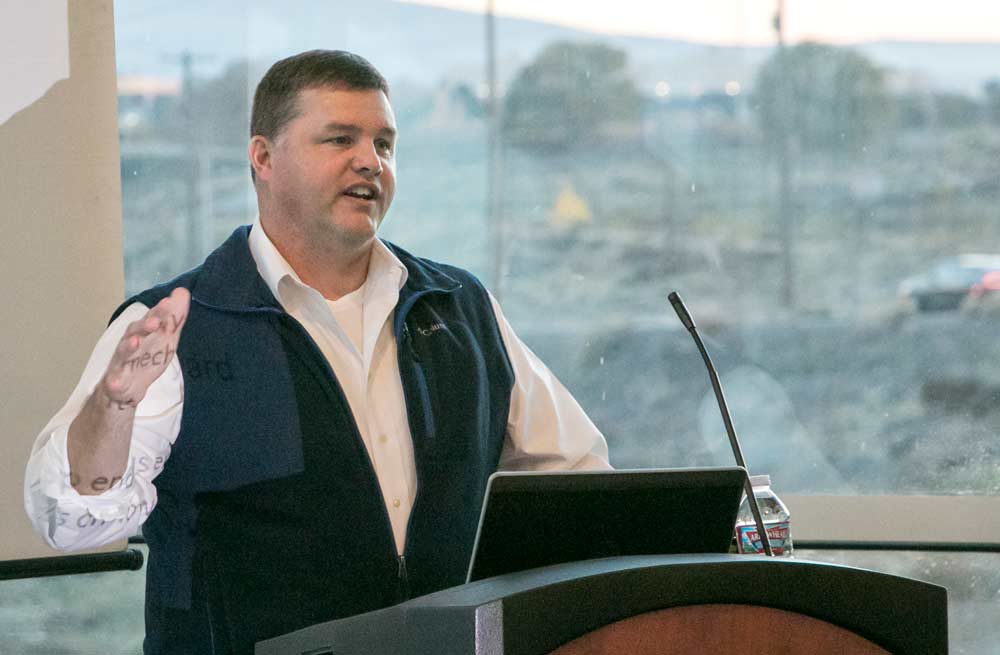
Terry Bates, director of the Cornell University Lake Erie Research and Extension center, describes a small crop research initiative project about variable crop management during the Ravenholt Lecture at the Washington State University Wine Science Center in Richland, Washington, in November. (Ross Courtney/Good Fruit Grower)
For the most part, grape growers treat their vineyard blocks as units, harvesting all the grapes at the same time, applying an even amount of nutrients and using the same level of pest protection. In ways, they treat all the vines the same.
Terry Bates, director of the Cornell Lake Erie Research and Extension Center, believes he has a better idea.
“What do you do when things are different in one end of the vineyard than the other end of the vineyard?” he asked growers during the Ravenholt Lecture at the Washington State University Wine Science Center in Richland, Washington.
Funded by a Specialty Crop Research Initiative Grant, Bates and his team aim to develop a system of automated sensors and GPS to create informative vineyard maps that a manager could use to tailor decisions about nutrients, pest management, irrigation and harvest to specific areas in the vineyard.
He calls it “variable vineyard management.”
“Either the goal is to make (the vineyard) more uniform or to embrace that it is not uniform and be able to do something like differential harvest, take advantage of that lack of uniformity to get the product that we want,” Bates said at the lecture in November.
The team received the two-year, $2.4 million grant after applying for a fifth time in 2015. However, the work started in 2014 with a pilot project funded by a National Grape and Wine Initiative grant.
“Prescription map”
The goal is “a prescription map,” a map of a vineyard that color-codes different spots based on information about the growth of the vines or readings from soils that a manager could use to guide his decisions. If one area needs more water, a grower can give only that spot more water. If another location has poor soil, he can fertilize only those vines.
Bates hails from the Lake Erie grape belt, a 60-mile ribbon of vineyards between Buffalo, New York, and Erie, Pennsylvania.
The region makes a living off lake effect weather that moderates growing conditions near the shores. Concords dominate, but the region has a growing wine industry, too, with 25 wineries now. Bates calls the area “about 10 years behind” Eastern Washington’s grape country.
Bates’ collaborators are Steve Nuske from Carnegie Mellon University, James Taylor from Newcastle University in England, Tim Weigle from Cornell University, and Julian Alston and Kaan Kurtural, both of University of California, Davis.
The Ravenholt Lecture Series brings grape industry professionals to Washington State University to share expertise. It is funded by an endowment from the Albert Ravenholt Foundation, named after the late founding partner of Sagemoor Vineyards in Pasco, Washington.
Longtime industry goal
Variable management for wine grapes — or any farm product — is not a new idea. It’s just another step toward precision farming. Row crops in the Midwest have been doing this for decades, adjusting fertilizer treatments based on soil conditions, said Michelle Moyer, extension viticulturist for Washington State University in Prosser, Washington.
The problem is doing that with grapes involves hilly terrain, new irrigation lines, extra passes down the row with a tractor and other costly techniques. Researchers have been looking for ways to make all those faster and cheaper for years. She believes Bates is getting there.
“He’s finally translating all that information into something we can physically do, and is reasonable to do,” Moyer said.
Bates and his team started their project with off-the-shelf tools, including soil sensors and NDVI cameras attached to ATVs or harvesters to measure canopy and crop load. His team also is trying to develop a Brix sensor to add to the mix.
The key trick is that his crews arrange the information “spatially” within vineyard blocks using GPS.
Then, with computer programs they designed, they create layers of maps that communicate with Google Earth to tell a grower, for example, which vines to prune and by how much or where to irrigate more and where to irrigate less.
“Now that means something to me as a grower, and I can act upon it,” Bates said.
In the end, he envisions a “black box” that contains all the information and can spit it out into decision-aid maps that pop up on a screen inside a harvester. In theory, a grower would be able to make all the decisions in advance and just drive, letting the computers control the details.
Larger growers who plan to be in the business for the long haul will be the most interested, said Mike Concienne, senior business partner for National Grape, the grower cooperative that owns Welch’s.
“Probably some of the bigger, more progressive growers we have would be more in tune to that type of practice,” he said. That would affect the bulk of the production. As a rough estimate, about 20 percent of the growers produce 80 percent of Washington’s juice grape tonnage, Concienne said.
The nation’s juice grape industry is in a period of contraction, as plentiful national concentrate inventories and recent large crops keep prices low.
Growers in Washington, the nation’s largest juice grape producer, and to a lesser extent New York, Pennsylvania and Michigan, have been removing juice grape acres in favor of fruit trees, wine grapes and hops.
However, Concienne expects that to level off eventually, making Bates’ work applicable down the road.
“I still think, this technology, there’s a place for it,” Concienne said. •
– by Ross Courtney






Leave A Comment